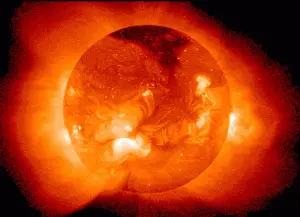The sun is the largest object in the solar system containing more than 99% of the solar system’s mass. It consists mainly of hydrogen, helium, and other metals. The proportion of  hydrogen and helium  keeps changing as there is a constant dynamic conversion of hydrogen to helium. The energy from this conversion is transmitted to Earth.  The sun, which has been in existence since 5 billion years ago, is continually growing in size and luminosity.
Fact 1. The sun is not as luminous as most stars. As a comparison of the 50 brightest stars visible to the human eye, the least bright is Alpha Centauri which is 1.5 times more luminous than the sun.
Fact 2. Â The sun is actually a green-blue star with a peak wavelength in the transition between blue and green. The temperature of a star is correlated to the color of its most predominate wavelength of emission. The sun’s surface temperature is 5,800Kelvin, which means it is predominantly green-blue. Â The human eye sees the sun as yellow due to a host of other colors being emitted.
Fact 3. Â Â Most of the major cultures and religions have practices and stories revolving around the sun. The sun has religious connotations in various cultures as the source of light and energy.
Fact 4. Â The Chinese interpretation of a solar eclipse is a dragon chasing and consuming the sun.
Fact 5.  Indo-European languages, as early as 6,000 years ago, had different but similar sounding names for the sun. Most of the words started with similar sounds such as (su-/saw-) but had different endings such as (-n or -l). E.g. suen, sáwel, sol.
Fact 6. In the Hindu religion, Surya is worshipped as the Sun god. The deity is depicted as pulled around in a chariot with seven horses or a horse with seven heads. The number ‘œseven’ represents the seven days of the week. In Egyptian culture, there is the worship of the Sun god Ra.
Fact 7. The modern scientific era began with Copernicus’s hypothesis in the de Revolutionibus (1543), stating the Sun was the center of the solar system. Sir Isaac Newton demonstrated that this was true in his document Principia (1687).
Fact 8. Â The Sun is a ‘œdwarf’ star, which means it is at a mature stage in its evolution.
Fact 9. Tiny, ice crystals in the Earth’s atmosphere cause the perception of halos around the sun due to the refraction of light.
Fact 10. In the future, the sun will reach a point when it will exhaust its hydrogen resource. Gravitational forces will cause an internal collapse. The energy from the implosion will cause the external part to expand engulfing nearby planets, Mercury and Venus. It will then move to a white dwarf stage before ending its mission as a black dwarf, 5 billion years from now.











Leave a Reply